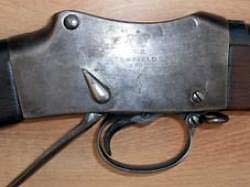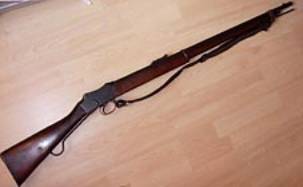The Martini-Henry rifle was adopted in 1871, featuring a falling-block single-shot breech-loading action, actuated by a lever beneath the wrist of the buttstock. The Martini-Henry evolved as the standard service rifle for almost 20 years, with variants including carbines.
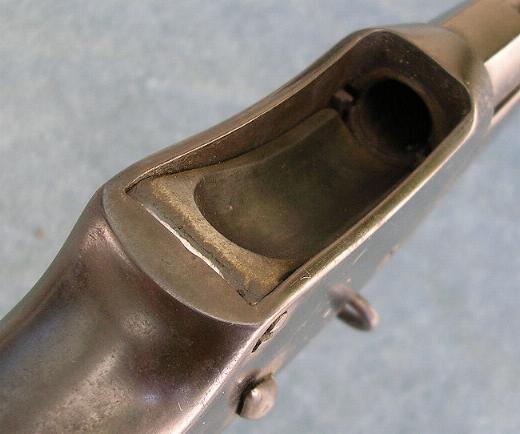 Unlike the Snider it replaced, the Martini-Henry was designed from the ground up as a breech-loading metallic cartridge firearm. This robust weapon uses a falling block, with a self-cocking, lever operated, single-shot action designed by a Swiss, Friedrich von Martini, as modified from the Peabody design. The rifling system was designed by Scotsman, Alexander Henry.
Unlike the Snider it replaced, the Martini-Henry was designed from the ground up as a breech-loading metallic cartridge firearm. This robust weapon uses a falling block, with a self-cocking, lever operated, single-shot action designed by a Swiss, Friedrich von Martini, as modified from the Peabody design. The rifling system was designed by Scotsman, Alexander Henry.
The Mark I was adopted for service in 1871. There were four main variations of the Martini-Henry rifle including the Mark II, III and IV with sub variations of these called patterns. In 1877 a carbine version entered service with five main variations including cavalry and artillery versions. Initially,
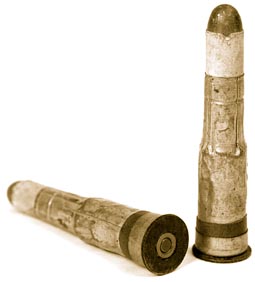 Martinis used the short chamber Boxer-Henry .45 calibre black powder cartridge made of a thin sheet of brass rolled around a mandrel, which was then soldered to an iron base. Later, the rolled brass case was replaced by a solid brass version which remedied a myriad of problems.
Martinis used the short chamber Boxer-Henry .45 calibre black powder cartridge made of a thin sheet of brass rolled around a mandrel, which was then soldered to an iron base. Later, the rolled brass case was replaced by a solid brass version which remedied a myriad of problems.
GENERALLY: The Martini-Henry should more properly be called the Peabody-Martini-Henry as it is actually the Peabody pattern modified to a self-cocking hammerless design through the work (and patent) of Friederich von Martini of Frauenfeld, Switzerland, and the rifling design of Edinburgh gunmaker Alexander Henry (which rifling itself is a modification of Joseph Whitworth's work!)
Britain's observations of the American Civil War (1861-1865), the Danish-Prussian War (1864), the adoption of the Prussian needle-gun and the French Chassepot (1866) convinced her of the need to modernize her arms to maintain parity with the rest of Europe. Additionally, this was a time of enormous Empire for Britain, covering over one million square miles of the earth's surface. This required arms of unusual flexibility.
In 1864 an Ordinance Select Committee was formed to find a replacement for the venerable P53. The committee recommended adoption of the Snider-Enfield as an interim measure, owing to the ease of conversion of huge stocks of P53s, but the committee also knew that a truly capable replacement would be needed in due time. The Snider did buy Britain that time.
After exhaustive trials, the then committee selected the Peabody-Martini in 1871, to which it added the Henry rifling system. Ammunition experiments with short .50 cal cartridges and long fragile cartridges, both unsatisfactory, led ultimately to the selection of the "Short Chamber" round with a .577 Snider base necked to .45in. Containing an 85 grain charge behind a 480 grain bullet this cartridge greatly extended the range of British infantry.
From its adoption in 1871 as the Mark I through the Mark IVc, the Martini-Henry would remain the mainstay of British Infantry forces until in and the Sniders were replaced by the Lee-Metford and its progeny in the 1890's. Some Martini-Henrys continued to soldier on with colonial forces well into the 20th century!
PHOTO: The rifles shown in the above photos a Martini-Henry Mk III and the late Mk IV.
- Photos below illustrate, for comparison, features of both the Mark I-II, an early Martini-Henry which started life as a Mark I and was transformed into a Mark II by the addition of an improved trigger assembly, redesigned trigger guard, refined sight, re-designed cleaning rod and plain buttplate in lieu of the serrated original, and a very late model Mark IV-1C.
DISTINGUISHING CHARECTERISTICS: The British Martini-Henry generally, is a hammerless rear-pivoting design based on the Peabody, operated by a cocking/loading lever behind the rigger guard. It is fitted with a 2-piece stock, the forestock affixed with conventional barrel bands, the buttstock mounted to the back of the receiver with a massive screw running from beneath the buttplate to the receiver back. Often unmarked on the left side of the receiver, except possibly small proofs just behind the barrel, the right side is profusely marked with a large crown over V.R. (Victoria Regina) over ENFIELD over the date of manufacture and an additional crown over broad arrow and then the Mark (as, e.g., "I" or "IV") and then possibly series and other marking. The right side also sports a cocking indicator which shows the status of the firing mechanism, back-cocked, vertical-uncocked, or fired. The barrel is often marked with numereous proofs on either side of the rounded knoxform. Buttstocks are very often well marked on the right side including the Enfield roundel cartouche, with date and Mark, and often carrying unit markings and extensive foreign service markings (denoting service everywhere from Nepal to India to the Sudan!)
Among the Marks: There are numerous small differences between and among the Marks and the reader is referred to the text by Dennis Lewis, recommended below, for a detailed account. In summary though, the Mark I will be dated pre-1877, be marked with a "I" on the right side of the receiver, have a serrated (fully chequered) buttplate (not definitive) short cocking lever, large cocking indicator lever and the lower sling swivel mounted on the buttstock below the cocking lever and a cleaning rod with a sharp shoulder. Most Mark Is were subsequently converted as noted to Mark I-IIs. The Mark II is similar to the Mark I but dated 1877 or later, marked with a II on the right of the receiver, smooth buttplate, lower swivel mounted at the front of the trigger guard, tulip-head cleaning rod with a slot and cam swell just above the upper band to both lock it into place and allow it to be withdrawn easily and sights with deepened notches. The Mark III was approved in 1879. The external appearance of the Mark IIIs differs little from the earlier Marks, however it differs in the mode of attaching the forearm to the receiver. This is done by means of a steel tang held by two screws attached to the underside of the forearm which, in turn, attach by means of a lug to the receiver rather than the earlier pin which ran transversely through the forestock ahead of the receiver and through a block on the bottom of the barrel. Consequently, there is no pin through the forestock on Mark IIIs. In addition, the barrel knox form had two flats instead of the one found on the Mks I and II. The III also introduced a smaller cocking indicator (taken from the carbine models). Receiver dates are usually post 1879 and marked with a "III". The butt is marked with the maker's roundel above a "III" above a "1".
Mark IV rifles presented the greatest external changes of all the marks. These came in the interim time during which the British were experimenting with the .402 calibre Enfield-Martinis. Large numbers of Enfield-Martinis had been produced at a time when the .303 Lee-Metford was just comming online and the .45 Martini was still in wide service. Thus most of the Enfield-Martinis were converted to Martini-Henrys by rebarreling and through maximum use of Enfield-Martini components. Approximately 100,000 Mark IVs were produced. Mark IV recognition is readily apparent. Most noticeably, the operating lever is substantially lengthened (5 inches!) to improve cartridge extraction problems which came to light after campaigns in the Sudan, and the receiver itself is rounded, cut down and sloped at the back to improve the grip of the rifle. The buttstock was narrowed and fitted with a correspondingly narrower buttplate affixed with brass screws to minimize rust freezing into place and brass liner between the buttplate and stock for the same reason. The operating lever cup is also often found in brass. The nosecap now had an integral cleaning rod catch, unlike all previous marks, and the cleaning rod, originally designed for use with the Enfield-Martini, was of a new design. The Mark IV was made in several patterns, denominated A, B and C. The A and B patterns are conversions of the Enfield-Martinis, while the Mark IV-1C pattern is either a mix of old and new parts or all new parts. Differences among the three Mark IV patterns are not great, the most apparent, however, being the ramp style front sight on the Bs and Cs as distinct from the barlycorn style on all previous models. All Mark IVs were made at Enfield and are receiver marked with Crown over V.R., over "Enfield", year of manufacture, small crown over broad arrow and marked "IV" over "1". The right side of the buttstock carries the Enfield roundel over IV over 1.
MISC NOTES: The British Military Martini MKs (Enfield Martinis):
Martini-Henry Infantry Rifle, MK I, 1871-1876
Martini-Henry Infantry Rifle, MK II, 1877-1881
Martini-Henry Infantry Rifle, MK III, 1881-1888
Martini-Henry Infantry Rifle, MK IV, 1888-1889
Martini Action Diagram
1 ACTION BODY
2 BREECHBLOCK
3 BREECHBLOCK AXIS PIN
4 STOP NUT
5 STRIKER
6 STRIKER SPRING
7 STOP NUT KEEPER SCREW
8 STOCK BOLT
9 LEVER/TUMBLER AXIS PIN KEEPER SCREW
10 LEVER/TUMBLER AXIS PIN
11 LEVER
12 TUMBLER
13 TRIGGER GUARD
14 TRIGGER SPRING
15 TRIGGER SPRING SCREW
16 TRIGGER
17 TRIGGER AXIS SCREW
18 EXTRACTOR
19 EXTRACTOR RETAINING SCREW
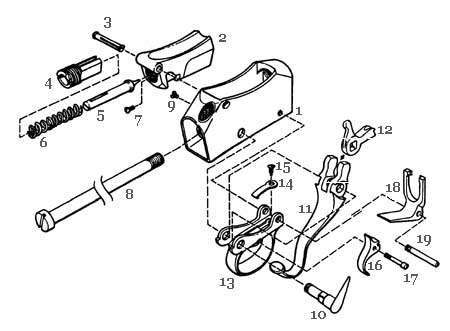
Note that the markings in the buttstock will sometimes appear as 'III' over 'I' for example. The first marking refers to the Mark of the weapon. The second marking refer to the class, and is sometimes amended in use. ie a Class one weapon ('I') would be downgraded to a second class ('II').
NON ENFIELD makers, such as BSA&M (Birmingham Small Arms & Manufacturing) continued to build the Mark II well into the age of the Mark IV, so do not be surprised to find a Mark II dated as late as 1889 although not built by the Royal Armoury at Enfield.
The three characteristics that make the Mk1 stand out from others are: 1 - the 'hinge pin (or axis) quite noticeably made of BRASS. The other Mk's are steel. 2 - the 'large cocking indicator as you can see by the pics extends into the crown design. Even at a distance or without looking at the date, you can pick out a Mk 1 from the others by this pin and the brass axis. 3 - the other is the button shaped ramrod head. Again a one-only design for the MK 1. The plate clearly shows the VR for Queen Victoria, Enfield for Enfield production, the date 1873 (these were introduced in 1871) and below this the numeral 1. for the Mk.
The Military Martini Henry .577”/.450” Rifle 1871-1900
Martini Henry MkI 1871-1877
After extensive trails The Martini Henry Mk1 entered production on 3rd June 1871. The first production patterns were Enfield produced, however as the rifle became adopted, LSA and BSA manufactured the model. The rifle entered service in the British army in 1872. The first models had features, which were discontinued on later models. The Pattern A, (1871) had a safety catch in the form of a small chequered thumb-piece near the trigger. This required a cut-out underneath the trigger guard and a slot to facilitate it on the base of the extractor. The receiver was also drilled to fit a locking screw. ( this is often found braze filled on upgraded models.) . The Breech-block was polished to allow easy inspection of the bore, however this proved very unpopular with the soldier as it was prone to rusting, even after a night in a tent. Subsequently on later models the breechblock was blued.
The Mark I pattern A had a solid bronze axis pin to retain the breechblock, this was held into place with a small locking screw, it was found, however that this often worked loose. In 1874 the pattern B, MkI had a sprung steel split cotter pin which required no locking nut and was easy to service and remove. The later pattern C July 17th 1874 began to closely resemble the MkII in development.
The Mark I Martin Henry went through various upgrades during its service timeframe.
Common / unique features of the MkI.
a) Chequer pattern steel butt plate.
b) Long Cocking indicator
c) Tulip head cleaning rod
d) Butt swivel (removed in 1875, often stocks are seen with wooden plug dowel infill)
e) Polished breech block
f) Low Notch leaf sight, replaced with V notch on later models.
g) Fore-end fitted via pin.( see image right)
h) Bronze axis pin, secured by locking screw
i)
Infill marks where safety catch removed.
Martini Henry MkII 1877-1879
On 25th April 1877 the pattern was set for the Martini Henry MKII, this was the rifle that saw service in some of the most famous battles fought during the 19th century. Early patterns of the MKII appear with dates between 1872-1876, this is the result of MkI components being
Upgraded or MkI rifles being factory upgraded. The common feature of upgraded rifles is the second numeral I stamped upon the receiver.
The MkII rifle had a new model rear sight, the MK1 sight notches were too fine for accurate sighting, so a deepened notch
Was introduced. Another essential design upgrade was a heavier nosed firing pin.
A new pattern cleaning rod was adopted, unlike the early pattern which was sprung into place, requiring the rod to be
Pulled clear. The new pattern had an annular ring that had area that was uncut. The user simply rotated the cleaning rod
around in the nosecap until the “flat spot” pushed the rod away from the slot.
Common with the MKI the MkII had the forend fastened by a pin. This was driven through the forend into a small
Lug hole on the underside of the knoxform.
Features also discontinued were the chequered butt plate, replaced by a ground smooth example.
Common Features of the MKII
a) Smooth buttplate
b) New pattern firing pin & breech-block
c) New pattern notched leaf sight
d) Re-designed trigger guard
e) Breech-block blued
f) Steel split breech-block axis pin
g)
Small cocking indicator (long indicator retained on most upgraded MKII)
Martini Henry MkIII 1879-1886
On 22nd August 1879 a new pattern Martini Henry was laid down, designated as the MKIII. The MkIII endorsed a lot of the improvements made on the MKII, the idea to make the rifle more robust. One of the key elements identified for improvement was the fixing of the fore-end to the receiver. On the Mk’s I-II, the for-end was fitted via a pin passing through a block under the knoxform. The MKIII had a brand new steel hook arrangement, which was mortised and screwed with two woodscrews onto the underside of the fore-end. This then had a raised lip, which engaged into a slot cast into the receiver.
The Mark III had a new firing pin, actually slightly narrower than the MKII which made the hole .002” wider in the breech block.
This gave the firing pin a little more clearance.
Martini Henry Mark 1V 1886-1908
During the latter period of the 1880’s European military planners were adopting smaller, faster moving projectiles in place of the massive, slower ballistic bullets favoured for the last 50 years. The result was the Mark IV Martini Enfield adopted on April 17 1886.
A new receiver design did away with the thumb-grip common through the first three marks, in favour of a humped block behind the breech. Another key design feature was the introduction of a new shaped butt stock, which was re-formed to provide a more comfortable grip and narrower.
The most radical change of specification was the extending of the action lever by 3” (75cm). This design feature was introduced to counter the problems of cartridge extraction experienced with earlier marks in arid or desert conditions. Also the base of the extraction claw was lengthened by ½” (12mm), this coupled with the greater leverage afforded a more positive extraction of a spent round. The breech itself was slightly narrower and chamfered underneath to accept the new pattern extractor. Purpose made components for the Mark IV are often found stamped E-M or III. It is not uncommon to find component parts fitted to earlier marks and subsequently scored through as E-M.
The Mark IV rifles appear in A,B & C patterns, the model featured above being an original pattern A. This gun was a .402” Martini, re-bored to .450”, the short knoxform has a small brazed panel where the short range foresight, a design feature of the Martini Enfield was removed. The A pattern retained the traditional Barleycorn on block foresight, however the B & C models carried a Barleycorn on ramp version.
The Mark IV rifle had a new pattern 32.75” cleaning rod. This rod was fitted with a annular ring 3 & 3/4” (95mm) from the end. Unlike previous marks which had a flat point on the rod to clear the muzzle. The MKIV rod was designed to be sprung into place, held in place by a retainer in the nose-cap.




